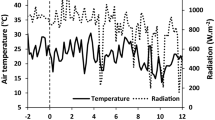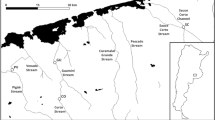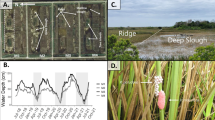Abstract
Sediment represents both a habitat and a trophic resource for many aquatic organisms, commonly known as deposit feeders. One of the most important freshwater invaders around the world is the polyphagous and opportunistic apple snail Pomacea canaliculata, in which deposit feeding has not been reported. Our aims were to study the frequency of sediment ingestion at different seasons in four watercourses within its natural range and to evaluate, under laboratory conditions, the relevance of this trophic resource for growth and survival of hatchlings and juveniles. Sediment ingestion showed very high (80–100%) and similar frequencies in snails from different waterbodies and at different seasons. This trophic behaviour was also recorded in laboratory experiments which allowed hatchlings to survive longer and to grow faster and in the case of juveniles to maintain their live weights with a high level of activity. Sediment ingestion by P. canaliculata juveniles also reduces organic matter content in the sediment. Sediment ingestion represents an alternative feeding behaviour for this apple snail whose relevance increases when other trophic resources are absent or scarce. This may help young individuals to survive and populations to persist during food shortages, increasing the chances of invasion. The reduction by P. canaliculata of the organic matter content in the sediments could alter the biogeochemical processes occurring in them and enhances the role of this apple snail as an ecosystem engineer in aquatic environments.





Similar content being viewed by others
Data availability
The datasets generated and analysed in the present research are available from the corresponding author on reasonable request.
References
Andrews EB (1965) The functional anatomy of the gut of the prosobranch gastropod Pomacea canaliculata and of some other pilids. P Zool Soc Lon 145(1):19–36
Carlsson NO, Brönmark C, Hansson LA (2004) Invading herbivory: the golden apple snail alters ecosystem functioning in Asian wetlands. Ecology 85:1575–1580
Chakraborty A, Saha GK, Aditya G (2022) A comparative study on the bioturbation ability of seven freshwater snail species. Aquat Ecol 57:35–52
Davidson AT, Dorn NJ (2017) Life history traits determine the differential vulnerability of native and invasive apple snails (Pomacea spp) to a shared juvenile-stage predator. Aquat Ecol 51(3):331–341
De Winter JC (2013) Using the Student’s t-test with extremely small sample sizes. Pract Assess Res Eval 18(1):10
Emery-Butcher HE, Beatty SJ, Robson BJ (2020) The impacts of invasive ecosystem engineers in freshwaters: a review. Freshwater Biol 65(5):999–1015
Fink P, von Elert E (2006) Physiological responses to stoichiometric constraints: nutrient limitation and compensatory feeding in a freshwater snail. Oikos 115(3):484–494
Gilioli G, Pasquali S, Martín PR, Carlsson N, Mariani L (2017) A temperature-dependent physiologically based model for the invasive apple snail Pomacea canaliculata. Int J Biometeorol 61:1899–1911
Glasheen PM, Burks RL, Campos SR, Hayes KA (2020) First evidence of introgressive hybridization of apple snails (Pomacea spp.) in their native range. J Molluscan Stud 86(2):96–103
Hakenkamp CC, Palmer MA (1999) Introduced bivalves in freshwater ecosystems: the impact of Corbicula on organic matter dynamics in a sandy stream. Oecologia 119(3):445–451
Hayes KA, Cowie RH, Thiengo SC, Strong EE (2012) Comparing apples with apples: clarifying the identities of two highly invasive Neotropical Ampullariidae (Caenogastropoda). Zool J Linn Soc-Lond 166(4):723–753
Hayes KA, Burks RL, Castro-Vazquez A, Darby PC, Heras H, Martín PR, Qiu JW, Thiengo SC, Vega IA, Wada T et al (2015) Insights from an integrated view of the biology of apple snails (Caenogastropoda: Ampullariidae). Malacologia 58:245–302
Horgan FG, Stuart AM, Kudavidanage EP (2014) Impact of invasive apple snails on the functioning and services of natural and managed wetlands. Acta Oecol 54:90–100
Horgan FG, Zhu Q, Portalanza DE, Felix MI (2021) Costs to Ecuador’s rice sector during the first decade of an apple snail invasion and policy recommendations for regions at risk. Crop Prot 148:105746
Kinoshita K, Tomiyama T (2022) Starvation tolerance of early stage Laguncula pulchella (Naticidae). J Shellfish Res 41(3):355–359
Kleinbaum DG, Klein M (2012) Survival analysis: a self-learning text, 3rd edn. Springer, New York
Krumins JA, van Oevelen D, Bezemer TM, De Deyn GB, Hol WG, Van Donk E, Van Der Putten WH (2013) Soil and freshwater and marine sediment food webs: their structure and function. Bioscience 63(1):35–42
Kwong KL, Chan RK, Qiu JW (2009) The potential of the invasive snail Pomacea canaliculata as a predator of various life-stages of five species of freshwater snails. Malacologia 51(2):343–356
Lawrence JR, Scharf B, Packroff G, Neu TR (2002) Microscale evaluation of the effects of grazing by invertebrates with contrasting feeding modes on river biofilm architecture and composition. Microb Ecol 44(3):199–207
Lopez GR, Levinton JS (2011) Particulate organic detritus and detritus feeders in coastal food webs. In: Wolanski E, Mclusky D (eds) Treatise on Estuarine and Coastal Science. Academic Press, Cambridge, USA, pp 5–21
López-van Oosterom MV, Ocon C, Ferreira AC, Rodrigues- Capítulo A (2016) The diet of Pomacea canaliculata (Gastropoda: Ampullariidae) in its native habitat based on gut content and stable isotopes analysis. Intropica 11:73–83
Lowe S, Browne M, Boudjelas S, De Poorter M (2000) 100 of the World’s Worst Invasive Alien Species. Invasive Species Specialist Group, International Union for Conservation of Nature, Auckland, New Zealand
Maldonado MA, Martín PR (2018) Dealing with a hypersuccessful neighbour: effects of the invasive apple snail Pomacea canaliculata on exotic and native snails in South America. Curr Zool 65:225–235
Maldonado MA, Manara E, Martín PR (2022) Macroinvertebrates in the diet of the apple snail Pomacea canaliculata in its native range. Malacologia 65(1/2):59–69
Manara E, Saveanu L, Martín PR (2016) Effects of ingestion of lithic particles on growth of the apple snail Pomacea canaliculata (Caenogastropoda, Ampullariidae). Malacologia 59(2):211–222
Manara E, Maldonado MA, Martín PR (2019) The role of an invader in its native range: Could differential grazing by apple snails structure the submersed macrophytes assemblages in Southern Pampas (Argentina)? Hydrobiologia 828:229–242
Manara E, Cambi V, Martin PR (2022) Evaluating the combined use of feeding trials and a micrographic technique to study the natural diet of Pomacea canaliculata. Limnologica 97:126022
Martín PR, Estebenet AL (2002) Interpopulation variation in life history traits of Pomacea canaliculata (Gastropoda: Ampullariidae) in southwestern Buenos Aires province, Argentina. Malacologia 44:153–163
Martín PR, Estebenet AL, Cazzaniga NJ (2001) Factors affecting the distribution of Pomacea canaliculata (Gastropoda: Ampullariidae) along its southernmost natural limit. Malacologia 43:13–23
Martín PR, Burela S, Seuffert ME, Tamburi NE, Saveanu L (2019) Invasive Pomacea snails: actual and potential environmental impacts and their underlying mechanisms. CAB Rev 14:042
Moran NP, Sánchez-Tójar A, Schielzeth H, Reinhold K (2021) Poor nutritional condition promotes high-risk behaviours: a systematic review and meta-analysis. Biol Rev 96(1):269–288
Morrison WE, Hay ME (2011) Herbivore preference for native vs. exotic plants: generalist herbivores from multiple continents prefer exotic plants that are evolutionarily naïve. PLoS ONE 6(3):e17227
Nghiem LTP, Soliman T, Yeo DCJ, Tan HTW, Evans TA, Mumford JD, Keller RP, Baker RHA, Corlett RT, Carrasco LR (2013) Economic and environmental impacts of harmful non-indigenous species in Southeast Asia. PLoS ONE 8:e71255
Raw JL, Perissinotto R, Miranda NAF, Peer N (2016) Feeding dynamics of Melanoides tuberculata (Müller, 1774). J Molluscan Stud 82(2):328–335
San Martín R, Ndjoko K, Hostettmann K (2008) Novel molluscicide against Pomacea canaliculata based on quinoa (Chenopodium quinoa) saponins. Crop Prot 27(3–5):310–319
Saveanu L, Martín PR (2013) Pedal surface collecting as an alternative feeding mechanism of the invasive apple snail Pomacea canaliculata (Caenogastropoda: Ampullariidae). J Molluscan Stud 79(1):11–18
Saveanu L, Martín PR (2014) Egg cannibalism in Pomacea canaliculata (Caenogastropoda: Ampullariidae) from southern Pampas: an alternative trophic strategy? Malacologia 57:341–351
Saveanu L, Martín PR (2015) Neuston: a relevant trophic resource for apple snails? Limnologica 52:75–82
Saveanu L, Manara E, Martín PR (2017) Carrion consumption and its significance in a freshwater trophic generalist: the invasive apple snail Pomacea canaliculata. Mar Freshw Res 68:752–759
Seuffert ME, Martín PR (2013) Distribution of the apple snail Pomacea canaliculata in Pampean streams (Argentina) at different spatial scales. Limnologica 43:91–99
Seuffert ME, Martín PR (2021) Exceeding its own limits: range expansion in Argentina of the globally invasive apple snail Pomacea canaliculata. Hydrobiologia 848(2):385–401
Seuffert ME, Burela S, Martín PR (2010) Influence of water temperature on the activity of the freshwater snail Pomacea canaliculata (Caenogastropoda: Ampullariidae) at its southernmost limit (southern Pampas, Argentina). J Therm Biol 35:77–84
Tamburi NE, Martín PR (2016) Effects of absolute fasting on reproduction and survival of the invasive apple snail Pomacea canaliculata in its native range. Curr Zool 62(4):369–375
Usseglio-Polatera P, Bournaud M, Richoux P, Tachet H (2000) Biological and ecological traits of benthic freshwater macroinvertebrates: relationships and definition of groups with similar traits. Freshwater Biol 43(2):175–205
Vaughn CC, Hakenkamp CC (2001) The functional role of burrowing bivalves in freshwater ecosystems. Freshwater Biol 46(11):1431–1446
Wieltschnig C, Fischer UR, Velimirov B, Kirschner AK (2008) Effects of feeding macrofauna on benthic bacteria, viruses, and protozoa in a silty freshwater sediment. Microbial Ecol 56(1):1–12
Yoshida K, Yusa Y, Yamanishi Y, Matsukura K, Wada T (2016) Survival, growth and reproduction of the invasive apple snail Pomacea canaliculata in an irrigation canal in southern Japan. J Molluscan Stud 82(4):600–602
Yusa Y, Sugiura N, Wada T (2006) Predatory potential of freshwater animals on an invasive agricultural pest, the apple snail Pomacea canaliculata (Gastropoda: Ampullariidae), in southern Japan. Biol Invasions 8(2):137–147
Zheng Z, Lv J, Lu K, ** C, Zhu J, Liu X (2011) The impact of snail (Bellamya aeruginosa) bioturbation on sediment characteristics and organic carbon fluxes in an eutrophic pond. Clean-Soil Air Water 39(6):566–571
Acknowledgements
LS and PRM are researchers and EM is a posdoctoral fellow in CONICET. This work was supported by Consejo Nacional de Investigaciones Científicas y Técnicas (PIP 11220170100236CO), Universidad Nacional del Sur (PGI 24B/232) and Agencia Nacional de Promoción de la Investigación, el Desarrollo Tecnológico y la Innovación (PICT 2012-1956). We wish to thank Mara Maldonado for her help with field work and to two anonymous reviewers for their helpful comments and constructive criticisms.
Author information
Authors and Affiliations
Contributions
LS and PRM: conceptualization, data sampling, sample analysis, statistical analyses and interpretation, writing, reviewing and editing; EM: data sampling, sample analysis, reviewing and editing.
Corresponding author
Ethics declarations
Conflict of interest
The authors say that they do not have a conflict of interest, nor are they in competition for resources or employment relationships.
Additional information
Communicated by Télesphore Sime-Ngando.
Publisher's Note
Springer Nature remains neutral with regard to jurisdictional claims in published maps and institutional affiliations.
Rights and permissions
Springer Nature or its licensor (e.g. a society or other partner) holds exclusive rights to this article under a publishing agreement with the author(s) or other rightsholder(s); author self-archiving of the accepted manuscript version of this article is solely governed by the terms of such publishing agreement and applicable law.
About this article
Cite this article
Saveanu, L., Manara, E. & Martín, P.R. Sediment ingestion in the invasive apple snail Pomacea canaliculata. Aquat Ecol 57, 433–442 (2023). https://doi.org/10.1007/s10452-023-10020-2
Received:
Accepted:
Published:
Issue Date:
DOI: https://doi.org/10.1007/s10452-023-10020-2




